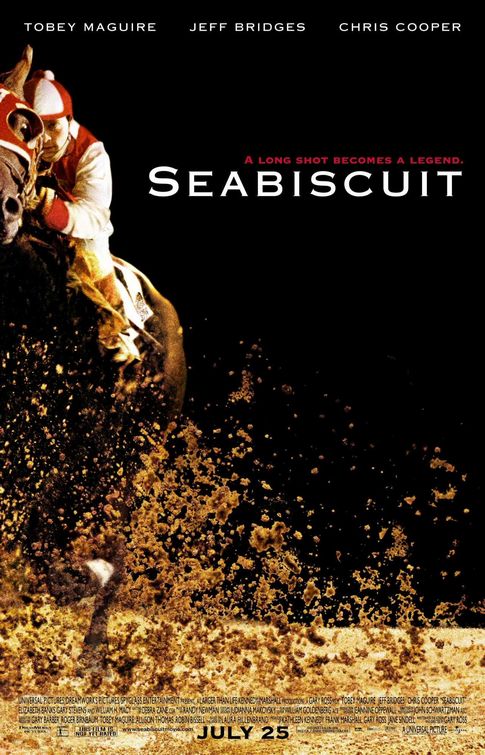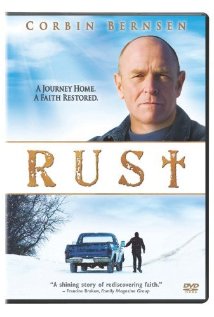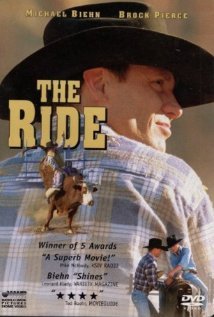| None | Light | Moderate | Heavy | |
|---|---|---|---|---|
| Language | ||||
| Violence | ||||
| Sex | ||||
| Nudity |
What You Need To Know:
The movie SEABISCUIT is a diamond in the rough. In a series of short, perfectly tailored vignettes, the audience meets the three central characters. Charles Howard is a self-made millionaire devastated by the loss of his son. Tom Smith, a rugged cowboy, is a man who’s lost his way of life and his purpose. Red Pollard, a too-tall failure of a jockey, still reels from the loss of his family. Though none of the characters meet until well into the movie, their stories intertwine from the beginning. Eventually, in the midst of the Great Depression, they are brought together by a mistreated horse named Seabiscuit, who has within himself the makings of a great champion.
SEABISCUIT is more than just a good horse movie. It’s a redemptive story that extols the value of giving people, and horses, a second chance. This belief is beautifully expressed in the line, stated twice, “You don’t throw a whole life away just ’cause it’s banged up a little.” Regrettably, the movie’s moral, patriotic tone is spoiled by many strong profanities and obscenities, some references to jockeys visiting prostitutes, and a couple very light socialist connotations favoring Big Government.
Content:
(BB, C, PPP, So, Pa, LLL, V, S, N, AA, D, M) Strong moral worldview extols giving second chances to people and contains brief Christian elements such as a church scene and a woman prays for hurt jockey, with very strong patriotic themes as well as two socialist elements regarding Big Government programs during Great Depression, including an implication that the State is our Big Daddy, and pagan content in scenes showing jockeys pursuing lives of hedonistic pleasure in Tijuana; 22 obscenities, 11 strong profanities, and one light profanity; mild violence during races, jockey participates in rough boxing matches, brief bullfighting scene where bull seems to be bleeding, jockey thrown and dragged from a horse and slams into a barn wall, shot of Pollard with leg at awkward angle; no depicted sex but jockeys visit prostitutes, prostitute undoes her blouse from behind for clothed customer lying on bed with her, and jockeys ride scantily clad women like horses at Tijuana brothel; woman’s nude back seen from behind, women in underwear, some upper male nudity, and girly pictures and statuettes in sportscaster’s booth made to look ridiculous; alcohol use and drunkenness; characters smoke throughout movie; and, lying and gambling in the background of horse races and boxing matches.
GENRE: Drama
BB
C
PPP
So
Pa
LLL
V
S
N
AA
D
M
More Detail:
SEABISCUIT is either the best episode of PBS’ AN AMERICAN EXPERIENCE ever made, or it is a movie with the most innovative use of narration and historical fact to tell a story. The movie opens with photographs of the era, easing the audience into America’s shoes during the Roaring Twenties. Many period films set the historic stage, then abandon it to tell the story of their characters, usually taking wild liberties with history in the process. SEABISCUIT, however, is the genuine article. It promises a 1930s movie, and it delivers. At times it’s hard to tell if Seabiscuit and company are being used to tell the story of America, or if America is being used to illuminate the characters. In either case, this movie, like its heroes, is a diamond in the rough.
In a series of short, perfectly tailored vignettes, the audience meets the three central characters. Charles Howard (played by Jeff Bridges) is a self-made millionaire devastated by the loss of his son. Tom Smith (played by Chris Cooper), a rugged cowboy, is a man who has lost his way of life and his purpose. Red Pollard (played by Tobey Maguire), a too-tall failure of a jockey, still reels from the loss of his family. Each man seeks to solve his own problems and fails, and, though none of the characters meet until well into the film, their stories intertwine from the beginning. While historian David McCullough’s familiar voice fills in the gaps in the audience’s historical knowledge, Gary Ross, the screenwriter and director, wraps his story around it, as a microcosm of the American experience.
When his wife leaves him after the death of their only son, Howard’s friends try to cheer him up by taking him to Tijauna, where he meets his second wife, the loving and lovely Marcela (played by Elizabeth Banks). Due to a U.S. ban on gambling, all of America’s racing greats are drawn to Tijuana to ply their trade. Among them are, of course, Tom Smith and Red Pollard. Howard meets Smith first and recognizes his talent immediately. Smith is a healer, a man who takes care of horses that others have deemed useless. When Howard asks him why he fixed up a broken horse, Smith looks at him as though he ought to know better and answers, “Because I could.” Confident that this is a man who can find him a champion, Howard hires him.
As it turns out, Smith is not only good at finding horses that people have forsaken, he also has the same talent for people. In a scene that can only be described as brilliant, Smith stands between the abused and ornery Seabiscuit fighting off his handlers and a fiery young red-headed jockey named Red fighting off a group of stableboys. Smith glances back and forth between the two, and he knows he has his jockey. The rest, as they say, is history. The unexpected four-way partnership that develops not only changes history, but it also changes them.
SEABISCUIT is an excellent movie on so many levels, it would be difficult to recount them all. Perhaps the most surprising element in the movie is the fact that, though it would appear to be a vehicle for rugged individualism, it actually goes out of its way to show that typical American grit isn’t enough to truly live. Despite the amazing feat of turning an abused, obstinate, no name horse into 1938’s Horse of the Year, and the even more amazing feat of bringing the same horse back from a career-ending injury, this movie shows that success is an empty goal. The true importance in these events is the effect they have on the lives of three men. Seabiscuit is a great racehorse, but ultimately he’s a healer himself, bringing Howard, Smith, and Pollard out of themselves and their dismal pasts and into the thing that Howard consistently emphasizes throughout the picture: the future.
SEABISCUIT is more than just a good horse movie. It is far more than a rags-to-riches Cinderella story. It is a story of redemption, and the truths expressed are deep and hard. Although the characters are able to help heal each other, no one’s problems simply disappear. The story’s central theme, expressed explicitly twice in the movie, is Smith’s philosophy. “You don’t throw a whole life away just ‘cause it’s banged up a little,” he tells Howard, who later uses the same line against him. The characters in this movie know they’re “banged up,” and, rather than define themselves by their lack of ability, or decide they’re healed because they succeed, they look to each other. In a way, this is an inherently Christian message.
The storytelling itself is masterful in SEABISCUIT. Gary Ross weaves brief vignettes of historic photographs and narration into the story. Most films use old photographs to compensate for a lack of authenticity in the film itself, to remind the audience of the period of the piece. Ross, however, uses them to tell the story, to heighten suspense, and to effectively place the audience in Depression-era America.
To further increase historical accuracy, Ross employs professional jockeys not just as extras in race sequences or stunt doubles, but even in starring roles. Gary Stevens, Hall of Fame jockey and winner of eight Triple Crown races, gives a delightful performance as George Woolf, Red Pollard’s more popular friend. Ironically, Stevens won the George Woolf Memorial Jockey Award. His appearance, and Chris McCarron’s race design, add an element of veracity to SEABISCUIT.
From costuming to choreography to the screenplay’s content, SEABISCUIT is truly a film about an historical period. It also puts the audience right among the jockeys as they battle for position during the movie’s exciting horse racing scenes.
Regrettably, however, SEABISCUIT’s positive qualities are spoiled by several objectionable elements. For example, the movie contains many strong profanities and obscenities, more than 30 instances of foul language all together. Early in the movie, there are also references to the jockeys visiting prostitutes. In one scene, Tobey Maguire’s character lies clothed on a bed while the camera shows a prostitute taking off her top, her naked back exposed to viewers. In another scene, jockeys ride scantily clad women like horses at a Tijuana whorehouse. Finally, the movie implies at one point that the Big Government, socialist policies of President Franklin Delano Roosevelt during the Great Depression made suffering Americans feel like they are “not alone.” In other words, the State is your Daddy or Mommy and, when in trouble, you should look to the President of the United States instead of your family, church, the Bible, the God who created you, or Jesus Christ, who saves you from your sins and helps you in times of need.
Only the foul language is pervasive throughout the movie, but all of the negative sounds and images could be completely cut out without ruining the movie’s story, atmosphere, or realism. Also, a Christian, God-centered filmmaker could have strengthened the movie’s positive elements to make an even stronger redemptive message.
Therefore, moviegoers should carefully consider whether they want to sit through the negative elements in SEABISCUIT. Still, in a season when movies packed with explosions and R-rated material dominate the box office, SEABISCUIT may follow its namesake’s example and prove to be a longshot worth betting on. When it is good, it is very, very good, so good, in fact, that it may be well be remembered next February during the Oscar ceremony. Not the least of its pleasures is the heartwarming performance by Jeff Bridges, one of America’s best actors.
Please address your comments to:
Stacey Snider, Chairman, Universal Pictures
Ron Meyer, President/COO, Universal Studios
100 Universal City Plaza
Universal City, CA 91608-1085
Phone: (818) 777-1000; Web Page: www.universalstudios.com
Now more than ever we’re bombarded by darkness in media, movies, and TV. Movieguide® has fought back for almost 40 years, working within Hollywood to propel uplifting and positive content. We’re proud to say we’ve collaborated with some of the top industry players to influence and redeem entertainment for Jesus. Still, the most influential person in Hollywood is you. The viewer.
What you listen to, watch, and read has power. Movieguide® wants to give you the resources to empower the good and the beautiful. But we can’t do it alone. We need your support.
You can make a difference with as little as $7. It takes only a moment. If you can, consider supporting our ministry with a monthly gift. Thank you.
Movieguide® is a 501c3 and all donations are tax deductible.

Now more than ever we’re bombarded by darkness in media, movies, and TV. Movieguide® has fought back for almost 40 years, working within Hollywood to propel uplifting and positive content. We’re proud to say we’ve collaborated with some of the top industry players to influence and redeem entertainment for Jesus. Still, the most influential person in Hollywood is you. The viewer.
What you listen to, watch, and read has power. Movieguide® wants to give you the resources to empower the good and the beautiful. But we can’t do it alone. We need your support.
You can make a difference with as little as $7. It takes only a moment. If you can, consider supporting our ministry with a monthly gift. Thank you.
Movieguide® is a 501c3 and all donations are tax deductible.




 - Content:
- Content: 






